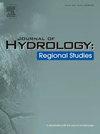水政策评估的计量经济学方法:以伊朗地下水表安装(GWMI)为例
IF 5
2区 地球科学
Q1 WATER RESOURCES
引用次数: 0
摘要
研究区域:伊朗Kor河和Sivand河流域。研究重点:伊朗20多年来的地下水枯竭促使最高水资源委员会(ISWC)批准了旨在减少地下水开采的GWMI政策。目前,虽然自全球环境监测指数获得批准以来已经过去了十年,并投入了大量资金,但尚未有研究试图评估其有效性。为了解决这一差距,本研究使用各种基于倾向得分的计量经济模型评估了GWMI在减少地下水抽取方面的表现。尽管所有模型都显示出可接受的拟合性并满足其假设,但结果表明,GWMI作为伊朗最重要的水政策之一,未能实现其在所有社会经济和水资源环境下减少地下水采取量的主要目标。这一结论是基于这样一个事实,即用于评估GWMI效果的平均处理效果(ATT)在任何模型中都没有统计学意义,尽管表明在某些地区井水取水量从763 m³ 到17,219 m³ 不等。研究表明,这种失败的主要原因是井的允许取水量与含水层的动态储水量不匹配,以及水价薄弱和仪表精度低。本文章由计算机程序翻译,如有差异,请以英文原文为准。
An econometric approach toward water policy assessment: A case of groundwater meter installation (GWMI) in Iran
Study region
The basins of Kor and Sivand Rivers, Iran.
Study focus
More than two decades of groundwater depletion in Iran, prompted the Supreme Water Council (ISWC) approve the GWMI policy, aiming to reduce the groundwater withdrawal. Currently, although a decade has passed since the approval of the GWMI and significant financial resources have been invested in it, yet, no study has attempted to evaluate its effectiveness. To address this gap, this study evaluated the performance of the GWMI in reducing groundwater withdrawal using various propensity score-based econometric models.
New Hydrological Insights for the Region
Although all models showed acceptable fit and met their assumptions, results indicate that the GWMI —as one of Iran's most important water policies— has failed to achieve its primary goal of reducing groundwater withdrawal under all socioeconomic and water resources circumstances. This conclusion is based on the fact that the Average Treatment Effect on the Treated (ATT), used to assess GWMI’s effects, was not statistically significant in any model, despite indicating a decrease in well water withdrawal ranging from 763 m³ to 17,219 m³ in some areas. This study showed that this failure was mainly due to the mismatch between permitted volume of water extraction of wells and the dynamic storage of the aquifers, as well as as weaknesses in water pricing and low accuracy of meters.
求助全文
通过发布文献求助,成功后即可免费获取论文全文。
去求助
来源期刊

Journal of Hydrology-Regional Studies
Earth and Planetary Sciences-Earth and Planetary Sciences (miscellaneous)
CiteScore
6.70
自引率
8.50%
发文量
284
审稿时长
60 days
期刊介绍:
Journal of Hydrology: Regional Studies publishes original research papers enhancing the science of hydrology and aiming at region-specific problems, past and future conditions, analysis, review and solutions. The journal particularly welcomes research papers that deliver new insights into region-specific hydrological processes and responses to changing conditions, as well as contributions that incorporate interdisciplinarity and translational science.
 求助内容:
求助内容: 应助结果提醒方式:
应助结果提醒方式:


